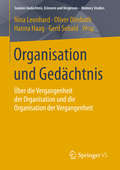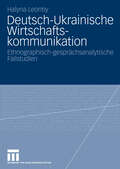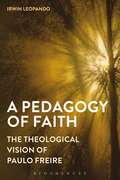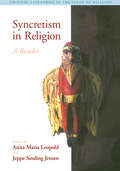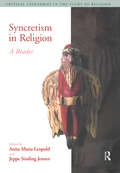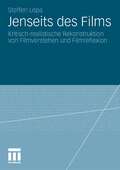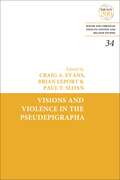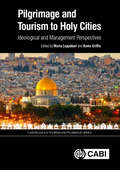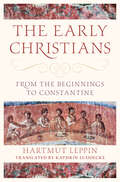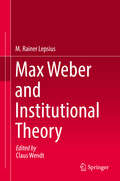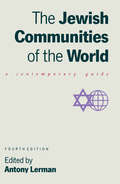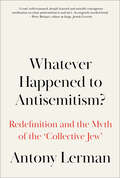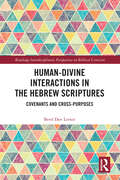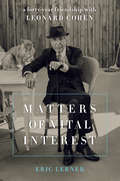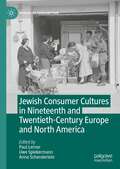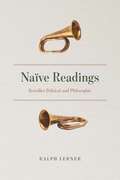- Table View
- List View
Organisation und Gedächtnis: Über die Vergangenheit der Organisation und die Organisation der Vergangenheit (Soziales Gedächtnis, Erinnern und Vergessen – Memory Studies)
by Nina Leonhard Oliver Dimbath Hanna Haag Gerd SebaldWie gehen Organisationen mit ihrer Vergangenheit um und was geschieht, wenn sie sich der Vergangenheit anderer annehmen? Der vorliegende Band versammelt Beiträge von Sozial-, Geschichts- und Wirtschaftswissenschaftler(inne)n, die diese Frage aus unterschiedlichen Perspektiven und für unterschiedliche Organisationstypen beleuchten. Zwei grundverschiedene Momente sozialer Gedächtnisse werden dabei adressiert: Zum einen muss davon ausgegangen werden, dass Organisationen ihre Strukturen pfadabhängig ausbilden und ihre Aktivitäten nur aus ihrer Vergangenheit heraus analysiert werden können. Diese Vergangenheit offenbart sich im Rückblick zum anderen aber nur selektiv und interpretativ – sie wird unter den Umständen gegenwärtiger Situationen immer neu konstruiert. Soziale Gedächtnisse der Organisation geben somit Orientierung für Prozesse des Organisierens. Zugleich kann es Gegenstand organisationalen Handelns sein, eine solche Orientierung für andere bereitzustellen.
Deutsch-ukrainische Wirtschaftskommunikation: Ethnografisch-gesprächsanalytische Fallstudien
by Halyna LeontiyZusammenfassung. . . . . . . . . . . . . . . . . . . . . . . . . . . . . . . . . . . . . . . . . . . . . . . . . . . . . . . . . . . . . . . . . . . . . . . . . . . . . . . . . . . . . . . . . . . . . . . . . . . . . . . . . . 17 1. Einleitung . . . . . . . . . . . . . . . . . . . . . . . . . . . . . . . . . . . . . . . . . . . . . . . . . . . . . . . . . . . . . . . . . . . . . . . . . . . . . . . . . . . . . . . . . . . . . . . . . . . . . . . . . . . . . 19 1. 1 Kommunikative Probleme in der interkulturellen Kommunikation. . . . . . . . . . . . . . . . . . . . . . . . . . 19 1. 2 Osteuropa – Westeuropa. . . . . . . . . . . . . . . . . . . . . . . . . . . . . . . . . . . . . . . . . . . . . . . . . . . . . . . . . . . . . . . . . . . . . . . . . . . . . . . . . . . . . . . . . . . . . . . . . . . 21 1. 3 Geschlecht als Kategorie in der interkulturellen Kommunikation. . . . . . . . . . . . . . . . . . . . . . . . . . . . . 22 1. 4 Ziele der Arbeit. . . . . . . . . . . . . . . . . . . . . . . . . . . . . . . . . . . . . . . . . . . . . . . . . . . . . . . . . . . . . . . . . . . . . . . . . . . . . . . . . . . . . . . . . . . . . . . . . . . . . . . . . . . . . . . . . . . 23 1. 5 Methodisches Vorgehen. . . . . . . . . . . . . . . . . . . . . . . . . . . . . . . . . . . . . . . . . . . . . . . . . . . . . . . . . . . . . . . . . . . . . . . . . . . . . . . . . . . . . . . . . . . . . . . . . . . . 25 1. 6 Aufbau der Arbeit. . . . . . . . . . . . . . . . . . . . . . . . . . . . . . . . . . . . . . . . . . . . . . . . . . . . . . . . . . . . . . . . . . . . . . . . . . . . . . . . . . . . . . . . . . . . . . . . . . . . . . . . . . . . . . . 26 2. Stand der Forschung. . . . . . . . . . . . . . . . . . . . . . . . . . . . . . . . . . . . . . . . . . . . . . . . . . . . . . . . . . . . . . . . . . . . . . . . . . . . . . . . . . . . . . . . . . . . . . . 29 2. 1 Begriffliche Klärung. . . . . . . . . . . . . . . . . . . . . . . . . . . . . . . . . . . . . . . . . . . . . . . . . . . . . . . . . . . . . . . . . . . . . . . . . . . . . . . . . . . . . . . . . . . . . . . . . . . . . . . . . . . 31 2. 1. 1 Zum Begriff der „interkulturellen Kommunikation“. . . . . . . . . . . . . . . . . . . . . . . . . . . . . . . . . . . . . . . . . . . . . . . . . . . . 31 2. 1. 2 Zum Begriff der „Kultur“. . . . . . . . . . . . . . . . . . . . . . . . . . . . . . . . . . . . . . . . . . . . . . . . . . . . . . . . . . . . . . . . . . . . . . . . . . . . . . . . . . . . . . . . . . . . . . . . . 32 2. 1. 3 Zum Begriff der „Kommunikation“. . . . . . . . . . . . . . . . . . . . . . . . . . . . . . . . . . . . . . . . . . . . . . . . . . . . . . . . . . . . . . . . . . . . . . . . . . . . . . . . 33 2. 1. 4 Kritik an der Charakterisierung der Kulturen und der Kulturdefinition. . . . . . . . . . . . . . . . . . . . 34 2. 2 Interkulturelle Kommunikation aus der Perspektive verschiedener Disziplinen. . . . . . . . . . . . . . . . . . . . . . . . . . . . . . . . . . . . . . . . . . . . . . . . . . . . . . . . . . . . . . . . . . . . . . . . . . . . . . . . . . . . . . . . . . . . . . . . . . . . . . . . . . . . . . . . . . . . . . . . . . . 36 2. 2. 1 Sprachwissenschaft. . . . . . . . . . . . . . . . . . . . . . . . . . . . . . . . . . . . . . . . . . . . . . . . . . . . . . . . . . . . . . . . . . . . . . . . . . . . . . . . . . . . . . . . . . . . . . . . . . . . . . . . . . . . . 36 2. 2. 2 Didaktik / interkulturelle Pädagogik. . . . . . . . . . . . . . . . . . . . . . . . . . . . . . . . . . . . . . . . . . . . . . . . . . . . . . . . . . . . . . . . . . . . . . . . . . . . . . . . 48 2. 2. 3 Kultursoziologie. . . . . . . . . . . . . . . . . . . . . . . . . . . . . . . . . . . . . . . . . . . . . . . . . . . . . . . . . . . . . . . . . . . . . . . . . . . . . . . . . . . . . . . . . . . . . . . . . . . . . . . . . . . . . . . . . . 54 2. 2. 4 Psychologie. . . . . . . . . . . . . . . . . . . . . . . . . . . . . . . . . . . . . . . . . . . . . . . . . . . . . . . . . . . . . . . . . . . . . . . . . . . . . . . . . . . . . . . . . . . . . . . . . . .
A Pedagogy of Faith: The Theological Vision of Paulo Freire
by Irwin LeopandoThis is the first book-length study in English to investigate Freire's landmark educational theory and practice through the lens of his lifelong Catholicism. A Pedagogy of Faith explores this often-overlooked dimension of one of the most globally prominent and influential educational thinkers of the past fifty years. Leopando illustrates how vibrant currents within twentieth-century Catholic theology shaped central areas of Freire's thought and activism, especially his view of education as a process of human formation in light of the divinely-endowed “vocation” of persons to shape culture, society, and history. With the contemporary resurgence of authoritarian political and cultural forces throughout much of the world, Freire's theologically-grounded affirmation of radical democracy, social justice, historical possibility, and the absolute dignity of the human person remains as vital and relevant as ever.
A Pedagogy of Faith: The Theological Vision of Paulo Freire
by Irwin LeopandoThis is the first book-length study in English to investigate Freire's landmark educational theory and practice through the lens of his lifelong Catholicism. A Pedagogy of Faith explores this often-overlooked dimension of one of the most globally prominent and influential educational thinkers of the past fifty years. Leopando illustrates how vibrant currents within twentieth-century Catholic theology shaped central areas of Freire's thought and activism, especially his view of education as a process of human formation in light of the divinely-endowed “vocation” of persons to shape culture, society, and history. With the contemporary resurgence of authoritarian political and cultural forces throughout much of the world, Freire's theologically-grounded affirmation of radical democracy, social justice, historical possibility, and the absolute dignity of the human person remains as vital and relevant as ever.
Syncretism in Religion: A Reader (Critical Categories in the Study of Religion)
by Anita M. Leopold Jeppe S. JensenLong a fascinating but problematic category of religious studies, "syncretism" is an elastic term that describes a wide range of practices characterized by the mixing or overlap of traditions. Syncretism in Religion offers the student a broad selection of essays, both classical contributions to the study of syncretism and new essays commissioned especially for this volume. Some important selections appear here in English for the first time. Also included is a list of references for further reading.
Syncretism in Religion: A Reader (Critical Categories in the Study of Religion)
by Anita Maria Leopold Jeppe Sinding JensenLong a fascinating but problematic category of religious studies, "syncretism" is an elastic term that describes a wide range of practices characterized by the mixing or overlap of traditions. Syncretism in Religion offers the student a broad selection of essays, both classical contributions to the study of syncretism and new essays commissioned especially for this volume. Some important selections appear here in English for the first time. Also included is a list of references for further reading.
Syncretism in Religion: A Reader (Critical Categories in the Study of Religion)
by Anita Maria Leopold Jeppe Sinding JensenSyncretism - the fusion of different beliefs into one religious system - has long been controversial in scholarship. It is widely held that religion, culture and ethnicity are pure entities that may become mixed in encounter and lead to impure, hybrid forms. 'Syncretism in Religion' presents a selection of essays committed to solving the problems of syncretism. The essays reflect the full breadth of religious traditions that could be called syncretistic. An overview of the historical background of syncretism is given, alongside classical readings from the history of religion, definitions of syncretism in relation to theories of power, and an assessment of the future of the subject. This volume brings together the work of authors who have made significant contributions in the field, some appearing for the first time in English. It will be of interest to any student or scholar of religion, philosophy or anthropology concerned with the dynamics of cultural contact and change.
Syncretism in Religion: A Reader (Critical Categories in the Study of Religion)
by Anita Maria Leopold Jeppe Sinding JensenSyncretism - the fusion of different beliefs into one religious system - has long been controversial in scholarship. It is widely held that religion, culture and ethnicity are pure entities that may become mixed in encounter and lead to impure, hybrid forms. 'Syncretism in Religion' presents a selection of essays committed to solving the problems of syncretism. The essays reflect the full breadth of religious traditions that could be called syncretistic. An overview of the historical background of syncretism is given, alongside classical readings from the history of religion, definitions of syncretism in relation to theories of power, and an assessment of the future of the subject. This volume brings together the work of authors who have made significant contributions in the field, some appearing for the first time in English. It will be of interest to any student or scholar of religion, philosophy or anthropology concerned with the dynamics of cultural contact and change.
Jenseits des Films: Kritisch-realistische Rekonstruktion von Filmverstehen und Filmreflexion
by Steffen LepaFlirty Little Secret
by Jessica LepeYou&’ve Got Mail meets Abbott Elementary in this sweet, sexy romantic comedy for fans of Lynn Painter and Lyssa Kay Adams. School counselor Lucy Galindo has a secret. To her coworkers, friends, and even family, she&’s shy, sweet, and constantly struggling to hold off disaster (read: manage her anxiety and depression). But online? She&’s bold, confident, and always knows what to say—it&’s how she&’s become the wildly popular @TheMissGuidedCounselor. It&’s also why she keeps her identity anonymous. Her followers would never trust the real Lucy with their problems. History teacher Aldrich Fletcher thought a new job would give him some relief from his drama-filled family. Instead, he&’s dodging his ex-girlfriend and pining over his new co-worker—who only ever seems to see him at his worst. Thankfully, he can count on his online confidant for advice . . . until he discovers @TheMissGuidedCounselor is Lucy. Now Fletcher has a secret too. And while Lucy can&’t deny there&’s something between them, she&’s not sure she can trust him. Can they both find the courage to share the truth and step out from behind their screens?
Visions and Violence in the Pseudepigrapha (Jewish and Christian Texts)
by Brian Leport Craig A. Evans Paul T. SloanThe nine essays that make up this volume provide cutting-edge studies of how sacred tradition is given new expression through vision and interpretation. The first four essays focus on the expansion of the sacred tradition primarily through vision. The evolution of the Solomon legacy, from wise king to healer and exorcist, is explored, as well as its contribution to the demonology of the desert fathers, especially as it concerns eroticism and sexual temptation. The varied receptions of the Revelation of the Magi and Shepherd of Hermas are also considered. The remaining five essays address important questions relating to polemic and violence in the Pseudepigrapha. How does the author of the Liber Antiquitatum Biblicarum justify God's alternating judgment and favor? How does Enoch's Animal Apocalypse make use of the Exodus tradition in its expression of deliverance? On what basis can the author of Qumran's War Scroll confidently predict Israel's vindication? And finally, what accounts for the appearance of the tradition of Gehenna, in which the wicked will meet their fiery end?
Pilgrimage and Tourism to Holy Cities: Ideological and Management Perspectives (CABI Religious Tourism and Pilgrimage Series)
by Maria Leppäkari Kevin GriffinThis book covers the ideological motives and religious perceptions behind travel to sites prescribed with sanctity in Judaism, Christianity and Islam. It covers sites that have drawn pilgrims and religious tourists to them for hundreds of years, and seeks to provide an understanding of the complex world of religiously motivated travel. Beginning with contemporary perspectives of pilgrimage across these religions, it then discusses management aspects such as logistics, infrastructure, malevolent behaviour and evangelical volunteers. This book: - Provides a collection of new, contemporary perspectives on pilgrimage. - Reviews the ideological motives, history, mental health, and religious perceptions of tourism to holy cities. - Contains practical applications, models and illustrations of religious tourism and pilgrimage management from a variety of international and academic perspectives. Written by subject experts, this book addresses cultural sustainability for researchers and practitioners within religious tourism, religious studies, geography and anthropology.
Classical Scholarship in Translation: From The Beginnings To Constantine (Classical Scholarship In Translation Ser.)
by Hartmut Leppin Kathrin LüddeckeMax Weber and Institutional Theory
by M. Rainer Lepsius Claus WendtThis book presents a collection of essays on institutional theory written by the German sociologist and Weber-expert M. Rainer Lepsius. Based on Weber’s work, the author develops concepts of institutional theory, which he subsequently applies to topics such as National Socialism, democratization processes, German unification, and the institutionalization of the European Union. By showing how charismatic leadership can under certain circumstances threaten democratic structures and curtail individual freedoms, and by analyzing the structural and cultural conditions under which people develop trust in political and social structures and ultimately come to support and comply with them, the author provides a sound analytical understanding of the development of democratic institutions and a democratic political culture. This collection of essays was edited, translated and commented on by Claus Wendt.
**Missing**: Das Wewelsburger Mahnmal von Josef Glahé (pop.religion: lebensstil – kultur – theologie)
by Stephanie LerkeAngesichts des Verstummens von Zeitzeug:innen und des Wiedererstarkens fremdenfeindlicher Motive und Mechanismen wie Antisemitismus, Rassismus und Rechtspopulismus ist Erinnerung an den Holocaust aktueller denn je. Gedenkstätten wie die „Erinnerungs- und Gedenkstätte Wewelsburg 1933 – 1945“ nahe Paderborn stellen in der gesellschaftlichen Erinnerungskultur als bildungspolitische Orte zur Erinnerung an die Opfer des Nationalsozialismus und der Mahnung an die leidvollen Ereignisse unter der nationalsozialistischen Diktatur eine notwendige Möglichkeit hierfür dar. Um sich mit dieser politisch sensiblen Geschichte und ihren aktuellen Erscheinungsformen auseinanderzusetzen, bedient sich die Wewelsburg des Ausdrucksmittels Kunst. Als erste umfassende interdisziplinäre Grundlagenforschung befasst sich dieses Buch mit jenem einzigartigen Stück bundesdeutscher Kunstgeschichte nach 1945, einer bildgewordenen, (un-)erwünschten Erinnerung aus einer theologischen Perspektive. Stephanie Lerke zeigtauf, dass das nachkriegsexpressionistische Wewelsburger Mahnmal von Josef Glahé den Betrachtenden durch sein breites Bildprogramm ein komplexes Themenfeld von historischen und theologischen Inhalten mit aktueller, erinnerungspolitischer Relevanz eröffnet. Sie verdeutlicht, wie dieses „zeitlose“ Medium mit seiner Fülle an Interpretationsspielräumen und Gegenwartsbezügen zur individuellen Spurensuche und Auseinandersetzung mit lebendiger Geschichte einlädt.
Jewish Communities of the World
by Anthony LermanThis fourth edition attempts to provide an up-to-date and comprehensive guide to Jewish life and institutions in 98 national communities worldwide. Entries include a brief historical outline and sections on legal status, communal organizations, religious life, education and welfare.
Whatever Happened to Antisemitism?: Redefinition and the Myth of the 'Collective Jew'
by Antony LermanAntisemitism is one of the most controversial topics of our time. The public, academics, journalists, activists and Jewish people themselves are divided over its meaning. Antony Lerman shows that this is a result of a 30-year process of redefinition of the phenomenon, casting Israel, problematically defined as the ‘persecuted collective Jew’, as one of its main targets. This political project has taken the notion of the ‘new antisemitism’ and codified it in the flawed International Holocaust Remembrance Alliance’s ‘working definition’ of antisemitism. This text is the glue holding together an international network comprising the Israeli government, pro-Israel advocacy groups, Zionist organisations, Jewish communal defence bodies and sympathetic governments fighting a war against those who would criticise Israel. The consequences of this redefinition have been alarming, supressing free speech on Palestine/Israel, legitimising Islamophobic right-wing forces, and politicising principled opposition to antisemitism.
Whatever Happened to Antisemitism?: Redefinition and the Myth of the 'Collective Jew'
by Antony LermanAntisemitism is one of the most controversial topics of our time. The public, academics, journalists, activists and Jewish people themselves are divided over its meaning. Antony Lerman shows that this is a result of a 30-year process of redefinition of the phenomenon, casting Israel, problematically defined as the ‘persecuted collective Jew’, as one of its main targets. This political project has taken the notion of the ‘new antisemitism’ and codified it in the flawed International Holocaust Remembrance Alliance’s ‘working definition’ of antisemitism. This text is the glue holding together an international network comprising the Israeli government, pro-Israel advocacy groups, Zionist organisations, Jewish communal defence bodies and sympathetic governments fighting a war against those who would criticise Israel. The consequences of this redefinition have been alarming, supressing free speech on Palestine/Israel, legitimising Islamophobic right-wing forces, and politicising principled opposition to antisemitism.
Human-Divine Interactions in the Hebrew Scriptures: Covenants and Cross-Purposes (Routledge Interdisciplinary Perspectives on Biblical Criticism)
by Berel Dov LernerThis book addresses central theological issues and biblical narratives in terms of a bold thesis regarding relations between God and humans: that the actions of God and the actions of humans are informed by independently valid moral viewpoints which do not entirely overlap. The author suggests that God’s plans and actions refl ect the interests and obligations appropriate to His goal of creating a worthy world, but not necessarily our world. In contrast, humans must attend to special obligations grounded in their dependence on their existing created world and in their particular places in the human family. However, in acts of grace, God voluntarily takes on special obligations toward the created world by entering covenants with its inhabitants. When the covenant involves reciprocal obligations, as in the case of God’s covenant with Israel, it also recruits human beings to play conscious roles in God’s larger plans. These covenants frame the moral parameters of human-divine interaction and cooperation in which each party strains to negotiate confl icts between its original duties and the new obligations generated by covenants. The interpretive discussions in this book involve close readings of the Hebrew text and are also informed by rabbinic tradition and Western philosophy. They address major issues that are of relevance to scholars of the bible, theology, and philosophy of religion, including the relationship between divine commands and morality, God’s responsibility for human suff ering, God’s role in history and the intersection between politics and religion.
Human-Divine Interactions in the Hebrew Scriptures: Covenants and Cross-Purposes (Routledge Interdisciplinary Perspectives on Biblical Criticism)
by Berel Dov LernerThis book addresses central theological issues and biblical narratives in terms of a bold thesis regarding relations between God and humans: that the actions of God and the actions of humans are informed by independently valid moral viewpoints which do not entirely overlap. The author suggests that God’s plans and actions refl ect the interests and obligations appropriate to His goal of creating a worthy world, but not necessarily our world. In contrast, humans must attend to special obligations grounded in their dependence on their existing created world and in their particular places in the human family. However, in acts of grace, God voluntarily takes on special obligations toward the created world by entering covenants with its inhabitants. When the covenant involves reciprocal obligations, as in the case of God’s covenant with Israel, it also recruits human beings to play conscious roles in God’s larger plans. These covenants frame the moral parameters of human-divine interaction and cooperation in which each party strains to negotiate confl icts between its original duties and the new obligations generated by covenants. The interpretive discussions in this book involve close readings of the Hebrew text and are also informed by rabbinic tradition and Western philosophy. They address major issues that are of relevance to scholars of the bible, theology, and philosophy of religion, including the relationship between divine commands and morality, God’s responsibility for human suff ering, God’s role in history and the intersection between politics and religion.
Matters of Vital Interest: A Forty-Year Friendship with Leonard Cohen
by Eric LernerA memoir of the author's decades-long friendship and spiritual journey with the late singer, songwriter, novelist, and poet Leonard Cohen Leonard Cohen passed away in late 2016, leaving behind many who cared for and admired him, but perhaps few knew him better than longtime friend Eric Lerner. Lerner, a screenwriter and novelist, first met Cohen at a Zen retreat forty years earlier. Their friendship helped guide each other through life's myriad obstacles, a journey told from a new perspective for the first time. Funny, revealing, self-aware, and deeply moving, Matters of Vital Interest is an insightful memoir about Lerner's relationship with his friend, whose idiosyncratic style and dignified life was deeply informed by his spiritual practices. Lerner invites readers to step into the room with them and listen in on a lifetime's ongoing dialogue, considerations of matters of vital interest, spiritual, mundane, and profane. In telling their story, Lerner depicts Leonard Cohen as a captivating persona, the likes of which we may never see again.
Jewish Consumer Cultures in Nineteenth and Twentieth-Century Europe and North America (Worlds of Consumption)
by Paul Lerner Uwe Spiekermann Anne SchenderleinThis book investigates the place and meaning of consumption in Jewish lives and the roles Jews played in different consumer cultures in modern Europe and North America. Drawing on innovative, original research into this new and challenging field, the volume brings Jewish studies and the history and theory of consumer culture into dialogue with each other. Its chapters explore Jewish businesspeople's development of niche commercial practices in several transnational contexts; the imagining, marketing, and realization of a Jewish national homeland in Palestine through consumer goods and strategies; associations between Jews, luxury, and gender in multiple contexts; and the political dimensions of consumer choice. Together the essays in this volume show how the study of consumption enriches our understanding of modern Jewish history and how a focus on consumer goods and practices illuminates the study of Jewish religious observance, ethnic identities, gender formations, and immigrant trajectories across the globe.
Naïve Readings: Reveilles Political and Philosophic
by Ralph LernerOne sure fact of humanity is that we all cherish our opinions and will often strongly resist efforts by others to change them. Philosophers and politicians have long understood this, and whenever they have sought to get us to think differently they have often resorted to forms of camouflage that slip their unsettling thoughts into our psyche without raising alarm. In this fascinating examination of a range of writers and thinkers, Ralph Lerner offers a new method of reading that detects this camouflage and offers a way toward deeper understandings of some of history’s most important—and most concealed—messages. Lerner analyzes an astonishing diversity of writers, including Francis Bacon, Benjamin Franklin, Edward Gibbon, Judah Halevi, Thomas Jefferson, Abraham Lincoln, Moses Maimonides, and Alexis de Tocqueville. He shows that by reading their words slowly and naïvely, with wide-open eyes and special attention for moments of writing that become self-conscious, impassioned, or idiosyncratic, we can begin to see a pattern that illuminates a thinker’s intent, new messages purposively executed through indirect means. Through these experimental readings, Lerner shows, we can see a deep commonality across writers from disparate times and situations, one that finds them artfully challenging others to reject passivity and fatalism and start thinking afresh.
Naïve Readings: Reveilles Political and Philosophic
by Ralph LernerOne sure fact of humanity is that we all cherish our opinions and will often strongly resist efforts by others to change them. Philosophers and politicians have long understood this, and whenever they have sought to get us to think differently they have often resorted to forms of camouflage that slip their unsettling thoughts into our psyche without raising alarm. In this fascinating examination of a range of writers and thinkers, Ralph Lerner offers a new method of reading that detects this camouflage and offers a way toward deeper understandings of some of history’s most important—and most concealed—messages. Lerner analyzes an astonishing diversity of writers, including Francis Bacon, Benjamin Franklin, Edward Gibbon, Judah Halevi, Thomas Jefferson, Abraham Lincoln, Moses Maimonides, and Alexis de Tocqueville. He shows that by reading their words slowly and naïvely, with wide-open eyes and special attention for moments of writing that become self-conscious, impassioned, or idiosyncratic, we can begin to see a pattern that illuminates a thinker’s intent, new messages purposively executed through indirect means. Through these experimental readings, Lerner shows, we can see a deep commonality across writers from disparate times and situations, one that finds them artfully challenging others to reject passivity and fatalism and start thinking afresh.
Naïve Readings: Reveilles Political and Philosophic
by Ralph LernerOne sure fact of humanity is that we all cherish our opinions and will often strongly resist efforts by others to change them. Philosophers and politicians have long understood this, and whenever they have sought to get us to think differently they have often resorted to forms of camouflage that slip their unsettling thoughts into our psyche without raising alarm. In this fascinating examination of a range of writers and thinkers, Ralph Lerner offers a new method of reading that detects this camouflage and offers a way toward deeper understandings of some of history’s most important—and most concealed—messages. Lerner analyzes an astonishing diversity of writers, including Francis Bacon, Benjamin Franklin, Edward Gibbon, Judah Halevi, Thomas Jefferson, Abraham Lincoln, Moses Maimonides, and Alexis de Tocqueville. He shows that by reading their words slowly and naïvely, with wide-open eyes and special attention for moments of writing that become self-conscious, impassioned, or idiosyncratic, we can begin to see a pattern that illuminates a thinker’s intent, new messages purposively executed through indirect means. Through these experimental readings, Lerner shows, we can see a deep commonality across writers from disparate times and situations, one that finds them artfully challenging others to reject passivity and fatalism and start thinking afresh.
